Results 1 to 10 of 84
Thread: Crocus finish or Satin?
Hybrid View
-
12-16-2015, 08:46 AM #1

Yep that's the stuff I use & was talking about. I thought it was hide glue ? Maybe not.
The white gleam of swords, not the black ink of books, clears doubts and uncertainties and bleak outlooks.
-
12-16-2015, 11:36 AM #2

Hide glue is made from animal hides and normally comes as crystal that are melted in a glue pot. Total pain in the rear end.
aka Michael Waterhouse
-
The Following User Says Thank You to mikew For This Useful Post:
onimaru55 (12-16-2015)
-
12-29-2015, 03:39 PM #3

Really an interesting thread! Thanks for bringing that up.
During the last 5 years or so I searched for - and spoke to - maybe a dozen old german grinders about polishing of blades. Traditionally the polishing process on blades and razors in Solingen is done on wheels of either wood surrounded by leather, felt or cork. The choice of the material depends on what you are polishing. For example if you polish a hollow grinded blade or razor, a felt wheel might be too soft, so that the edges get rounded, therefore cork or wood is the better alternative. Of course there are different grades of hardness of felt and harder felts may also be used, so every grinder has his own experiences.
The surface of the wheels are covered with emery, traditionally Naxos emery, which is glued with bone glue to the wheel. Nowadays also so-called red-glue is used, but a lot of the old grinders swear on the usage of bone glue.
For different stages of polishing, different grades of Naxos emery is used. The pre-polishing is done with coarser emery and is getting finer during the process, which can consist of 5 stages or even more . Last stage before the black- or mirror polishing is the so-called blue polishing. Here the finest emery is used, typically Naxos grade 5/0. During the blue polishing, the surface of the steel is densified. Polishing does not only mean to cut the peaks of the metal surface but also to fill the valleys with material. After the blue polishing process, the surface of the steel shines blueish if turned into the light, hence the name. The surface of steel is somehow sealed after this stage of Polishing, therefore the knifes made of carbon steel don't oxidize too much and too fast. The blue polishing of knifes in Solingen was very famous in the past and still is today, of course it doesn't make the steel inoxidable, but somehow inactive to rust.
The mirror or black polishing is one stage further. Normally the same wheels are used that already did the blue polishing, means, no finer emery is used. Additional pastes help to do the special polishing effect. Nearly all of the grinders I spoke too, have their secrets, what to use, how long, which formular, etc.
Traditionally in Solingen Vienna chalk mixed with rape oil was applicated on the wheels. Vienna chalk is very soft, so depending on the hardness of the steel and the steel itself, also other materials have been used. Sometimes special polishing mops do the final polishing process.Last edited by hatzicho; 12-29-2015 at 05:57 PM.
-
The Following 7 Users Say Thank You to hatzicho For This Useful Post:
cheetahmeatpheonix (01-05-2016), Euclid440 (12-29-2015), Geezer (01-05-2016), karlej (12-29-2015), RezDog (12-29-2015), Wolfpack34 (12-29-2015), WW243 (12-29-2015)
-
12-29-2015, 04:48 PM #4

Great Post Peter...I don't know if Naxos emery can be purchased today but I guess I'll be trying to find some. Really good info!
Lupus Cohors - Appellant Mors !
-
12-29-2015, 05:09 PM #5Senior Member




- Join Date
- Feb 2013
- Location
- Haida Gwaii, British Columbia, Canada
- Posts
- 14,455
Thanked: 4830
I could not agree more. Awesome Peter.
It's not what you know, it's who you take fishing!
-
12-29-2015, 06:00 PM #6I used Nakayamas for my house



- Join Date
- Aug 2009
- Location
- Des Moines
- Posts
- 8,664
- Blog Entries
- 1
Thanked: 2591
I got a flint hard felt wheel recently and now am waiting on some synthetic 1 micron iron oxide , curious to see how it will work out.
I also plan on making some wooden wheels with leather . I am not sure if the rough side of the leather should be facing out or the smooth side? My guess would be the rough side.Stefan
-
12-29-2015, 06:18 PM #7

Iron oxide should work fine. The problem is how to bring it on the wheel! You need to glue it on the wheel or produce a paste that you can use.
The production of wooden wheels with leather is not an easy thing. The connection between the wood and the leather must be very good, otherwise the leather is thrown away when the wheel turns. Could be very dangerous!
The rough side of the leather is glued to the wood. Make sure that you roughen the leather with a file. The wood should have some rills that will be filled with glue for better bonding. Glue the leather stripes to the wood and fix them with nails. The nails are only driven partly in the wood so that they can be removed after the glue is fixed.
Regards Peter
-
The Following User Says Thank You to hatzicho For This Useful Post:
Geezer (01-05-2016)
-
04-24-2020, 08:43 PM #8some like it wet

- Join Date
- Feb 2013
- Location
- Istanbul
- Posts
- 64
Thanked: 6
Sorry to revive this old thread, but I have been wondering something about vintage Solingen razors. The semi-polished or satin polished razors have a special pattern of grinding or maybe polishing Whee marks l that you can not achieve that mark pattern with a belt grinder or buffing felt. Maybe I cannot express my idea well enough because my English is not good. If you kindly look at the pictures below I am sure you will understand easily. The marks or trails of grinding or polishing Wheel is very neat and even. there is no up and downs between marks. You can see this pattern even on the razors of these days producers like dovo and wacker, but not on böker razors or french razor producer thiers issard razors. Do you know how can they do this pattern.
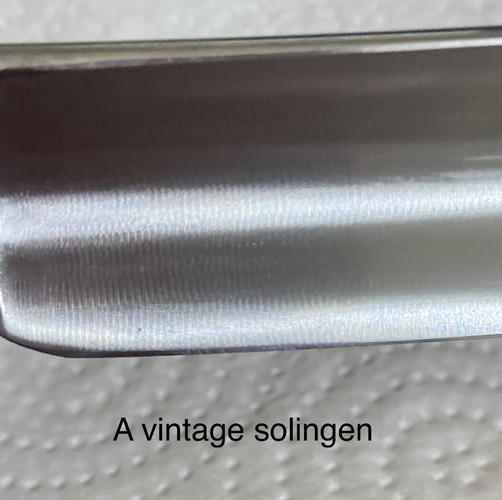

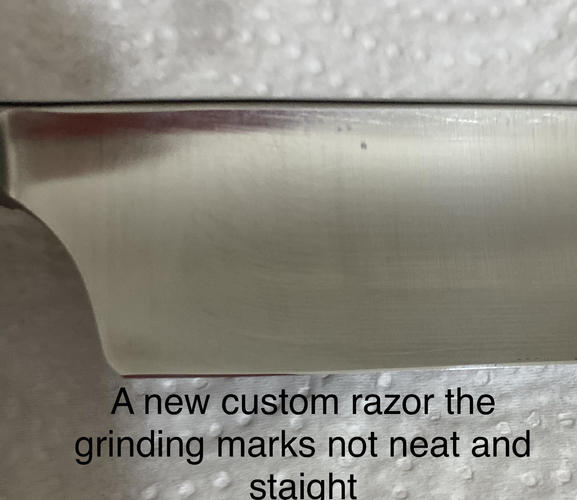 Oh yeaah, Some like it wet !!!!!
Oh yeaah, Some like it wet !!!!!
-
04-25-2020, 12:48 AM #9Senior Member



- Join Date
- Apr 2012
- Location
- Diamond Bar, CA
- Posts
- 6,553
Thanked: 3215
The top razor appears to have grinding marks left over, that were not completely buffed out, then a satin finish was applied, possibly from a scotchbrite wheel.
To get a good satin finish, it must first be polished to a mirror finish,(hand sanded to 2000 wet and dry) then buffed on a hard and loose cotton or soft felt wheel with red or white rouge, then brought down, hand sanded to a satin with 600 wet & dry sanding in one direction only.
There are many good examples, looking at Mike’s (Wolfpack34’s) razors or at Nick Wheeler’s YouTube channel.
What we were trying to achieve in this thread was the Old, pre 1900’s Black Polish finish, a deep flawless mirror finishes of the better-quality Sheffield razors. Made with segmented seal skin wheels and Crocus powder.
I think Mike got pretty close.
On both the middle razor and the last (custom), the stria pattern runs both vertical and horizontal.
Are you trying to replicate the even stria pattern satin finish on the first razor or eliminate all the stria with a mirror finish?
-
The Following User Says Thank You to Euclid440 For This Useful Post:
taskind (04-25-2020)
-
04-25-2020, 02:34 AM #10Senior Member



- Join Date
- Apr 2012
- Location
- Diamond Bar, CA
- Posts
- 6,553
Thanked: 3215
Here are a some pics of a couple of Mike’s, (Wolfpack34) razors, one in satin with bright spine and tang and one full Crocus bright finish.
I have seen Mike’s work in person, and it is flawless. The photos do not do it justice.
Here is the youtube video of Nick Wheeler, how to Satin Finish. I have seen his work in person also, it too is beautiful.
Here is the link to Wheeler Knives how to hand sand a Satin finish.
(
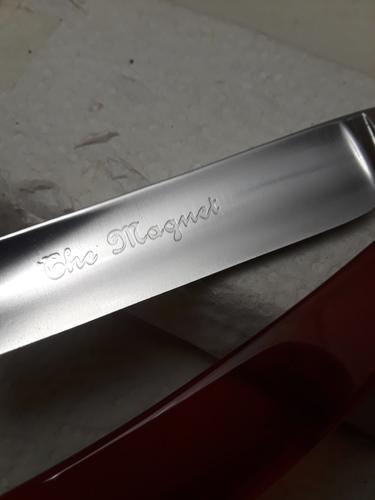
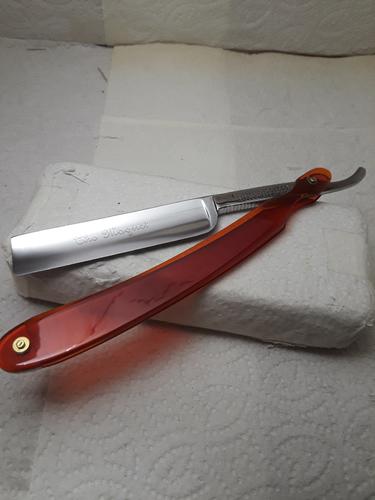
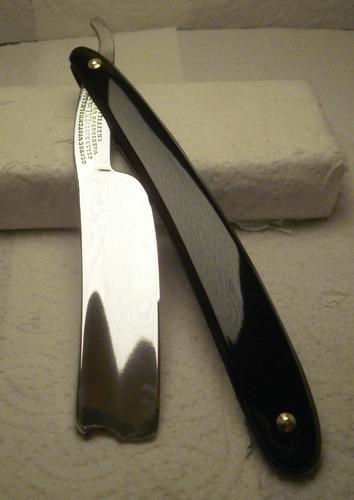

-
The Following User Says Thank You to Euclid440 For This Useful Post:
taskind (04-25-2020)


 221Likes
221Likes LinkBack URL
LinkBack URL About LinkBacks
About LinkBacks







 Reply With Quote
Reply With Quote

